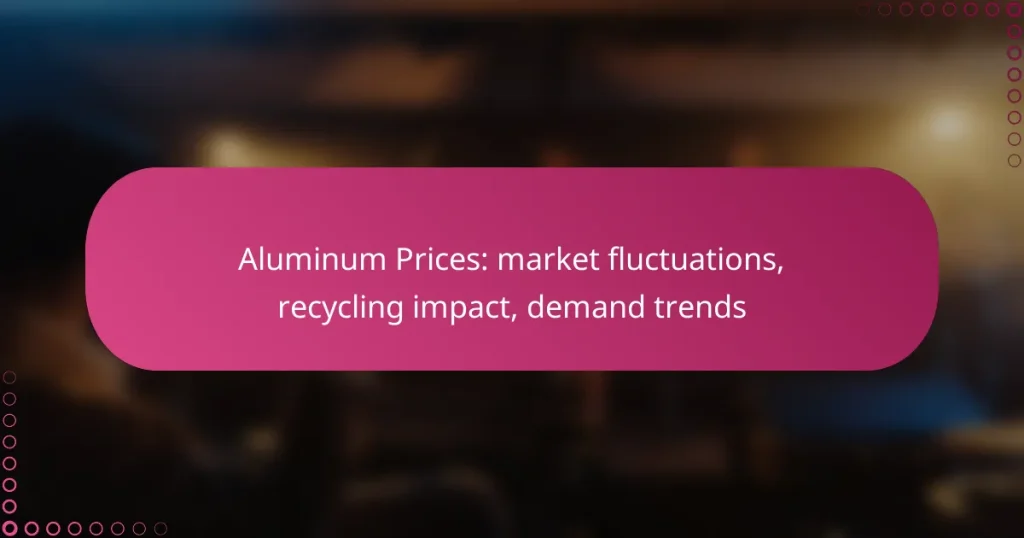Aluminum prices in the US are subject to fluctuations influenced by supply and demand dynamics, global market trends, and economic conditions. The recycling of aluminum plays a crucial role in stabilizing prices by reducing production costs and increasing supply, while the demand for aluminum continues to rise in key sectors such as construction, automotive, and packaging, driven by a focus on lightweight materials and sustainability.

How do aluminum prices fluctuate in the US market?
Aluminum prices in the US market fluctuate based on various factors, including supply and demand dynamics, global market trends, and economic conditions. These fluctuations can significantly impact industries reliant on aluminum, such as automotive and construction.
Current price trends
As of late 2023, aluminum prices have shown a tendency to stabilize after experiencing volatility earlier in the year. Prices typically range between $2,200 and $2,800 per metric ton, influenced by both domestic production levels and international demand.
Market analysts observe that prices may rise in response to increased demand from sectors like electric vehicles and renewable energy, which require significant aluminum components. Monitoring these trends can help businesses make informed purchasing decisions.
Factors influencing price changes
Several key factors influence aluminum price changes, including production costs, energy prices, and trade policies. For instance, rising energy costs can lead to higher production expenses, which often get passed on to consumers in the form of increased prices.
Additionally, tariffs and trade agreements can impact the availability of imported aluminum, further affecting domestic prices. Companies should stay informed about regulatory changes that could influence their supply chains and costs.
Historical price comparisons
Historically, aluminum prices have experienced significant fluctuations, with notable peaks during periods of high demand or supply chain disruptions. For example, prices surged to over $3,000 per metric ton in 2021 due to pandemic-related supply issues.
Comparatively, prices have generally trended lower in the past decade, averaging around $1,800 to $2,200 per metric ton before recent spikes. Understanding these historical trends can provide context for current market conditions and future expectations.

What is the impact of recycling on aluminum prices?
Recycling significantly influences aluminum prices by reducing production costs and increasing supply. As more recycled aluminum enters the market, it can stabilize or even lower prices compared to primary aluminum sourced from raw materials.
Recycling rates in North America
In North America, recycling rates for aluminum are relatively high, often exceeding 70%. This means a large portion of aluminum products, such as cans and automotive parts, are recycled rather than discarded. Higher recycling rates contribute to a more sustainable market and help mitigate price volatility.
Efforts to improve recycling infrastructure and consumer awareness continue to enhance these rates. Local programs and regulations play a crucial role in encouraging recycling practices across communities.
Cost savings from recycled aluminum
Using recycled aluminum can lead to significant cost savings, often estimated at 70% less energy consumption compared to producing new aluminum. This reduction in energy use translates into lower production costs, which can positively affect market prices.
Additionally, recycled aluminum requires less processing and fewer raw materials, making it an economically attractive option for manufacturers. Companies that prioritize recycled aluminum can benefit from reduced operational costs and potentially pass savings on to consumers.

What are the demand trends for aluminum in 2023?
In 2023, aluminum demand is primarily driven by its applications in construction, automotive, and packaging industries. The ongoing shift towards lightweight materials and sustainability initiatives is further fueling this trend.
Key industries driving demand
The construction industry is a significant consumer of aluminum, utilizing it for window frames, roofing, and structural components due to its durability and lightweight properties. Additionally, the automotive sector is increasingly adopting aluminum to enhance fuel efficiency and reduce emissions, with many manufacturers incorporating it into vehicle designs.
Packaging is another crucial area, as aluminum is widely used for beverage cans and food packaging, benefiting from its recyclability and ability to preserve product quality. The growth in e-commerce has also led to increased demand for aluminum in packaging solutions.
Forecasted demand growth
Demand for aluminum is expected to grow moderately over the next few years, with estimates suggesting an increase of several percent annually. This growth is influenced by rising construction projects and the automotive industry’s transition to electric vehicles, which often use more aluminum to offset battery weight.
Market analysts predict that the demand for recycled aluminum will also rise, driven by environmental regulations and consumer preference for sustainable products. Companies that prioritize recycling processes may gain a competitive edge as the market evolves.

How does global supply chain affect aluminum pricing?
The global supply chain significantly impacts aluminum pricing by influencing availability and production costs. Disruptions in supply chains can lead to fluctuations in prices due to changes in demand and supply dynamics.
Major suppliers and their influence
Major suppliers of aluminum, such as China, Russia, and Canada, play a crucial role in determining market prices. Their production levels, export policies, and geopolitical situations can directly affect global supply and, consequently, pricing.
For instance, if a leading supplier faces production cuts due to environmental regulations or political tensions, it can create a supply shortage, driving prices higher. Conversely, increased production from these suppliers can lead to lower prices in the market.
Shipping costs and logistics
Shipping costs and logistics are vital components affecting aluminum pricing. Fluctuations in fuel prices, port congestion, and shipping routes can all contribute to the overall cost of transporting aluminum from suppliers to consumers.
For example, if shipping costs rise due to increased fuel prices or delays at major ports, the final price of aluminum may increase as suppliers pass on these costs to buyers. Efficient logistics and strategic planning can help mitigate these costs and stabilize prices.

What are the implications of tariffs on aluminum prices?
Tariffs on aluminum can significantly influence market prices by increasing costs for importers, which may be passed on to consumers. These tariffs can lead to higher domestic prices, affecting both manufacturers and end-users in various industries.
Recent tariff changes
In recent years, several countries have implemented or adjusted tariffs on aluminum imports to protect local industries. For instance, the United States has maintained tariffs of around 10% on aluminum imports from certain countries, impacting global pricing dynamics. These changes can lead to fluctuations in aluminum prices, often resulting in increased costs for consumers and manufacturers alike.
Effects on domestic producers
Domestic producers often benefit from tariffs as they face less competition from foreign suppliers, allowing them to raise prices and potentially increase profit margins. However, this protection can also lead to complacency, reducing the incentive for innovation and efficiency. Additionally, higher prices may drive some manufacturers to seek alternatives or reduce production, impacting overall market supply.

How do economic indicators correlate with aluminum prices?
Economic indicators such as inflation rates and construction market trends significantly influence aluminum prices. Fluctuations in these indicators can lead to changes in demand and supply, ultimately affecting pricing in the market.
Relationship with inflation rates
Aluminum prices often rise during periods of high inflation. As the cost of raw materials and production increases, manufacturers pass these costs onto consumers, leading to higher prices for aluminum products.
Conversely, when inflation is low or stable, aluminum prices tend to stabilize as well. Investors and businesses may find it beneficial to monitor inflation trends to anticipate potential price changes in aluminum.
Impact of construction market trends
The construction industry is a major consumer of aluminum, and trends in this sector directly impact aluminum prices. When construction activity is robust, demand for aluminum increases, driving prices higher.
In contrast, during economic downturns or slow construction periods, demand for aluminum can decrease, leading to lower prices. Keeping an eye on construction permits and housing starts can provide insights into future aluminum price movements.

What are the future trends in aluminum pricing?
Future trends in aluminum pricing are influenced by various factors including global demand, recycling rates, and market fluctuations. As industries continue to evolve, understanding these trends can help stakeholders make informed decisions.
Market fluctuations
Aluminum prices are subject to significant fluctuations due to changes in supply and demand dynamics. Factors such as geopolitical tensions, trade policies, and economic conditions can lead to price volatility. For instance, disruptions in major aluminum-producing countries can cause prices to spike, while increased production can lead to lower prices.
Monitoring market indicators, such as inventory levels and production rates, can provide insights into potential price movements. Investors and manufacturers should stay informed about global economic trends and adjust their strategies accordingly to mitigate risks associated with price changes.
Recycling impact
The recycling of aluminum plays a crucial role in stabilizing prices and reducing environmental impact. Recycled aluminum requires significantly less energy to produce compared to primary aluminum, which can lead to cost savings and lower prices in the long run. As sustainability becomes a priority for many industries, the demand for recycled aluminum is expected to increase.
Companies that invest in recycling technologies can benefit from reduced raw material costs and contribute to a circular economy. Understanding local recycling regulations and incentives can further enhance profitability and market positioning.
Demand trends
Demand for aluminum is projected to grow in various sectors, including automotive, construction, and packaging. The shift towards lightweight materials in transportation is driving increased aluminum usage, as it helps improve fuel efficiency. Additionally, the rise of electric vehicles is expected to further boost demand for aluminum components.
Stakeholders should analyze sector-specific trends and consider regional market demands when planning production and investments. Engaging with industry forecasts and reports can provide valuable insights into future demand patterns and help businesses adapt to changing market conditions.


